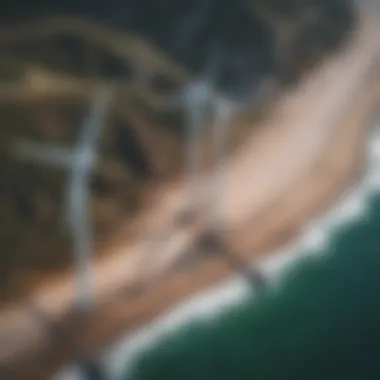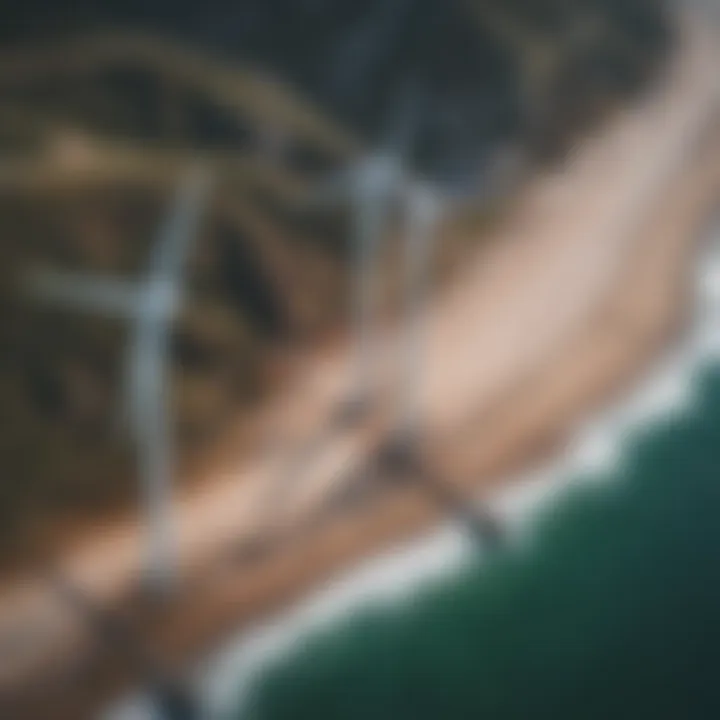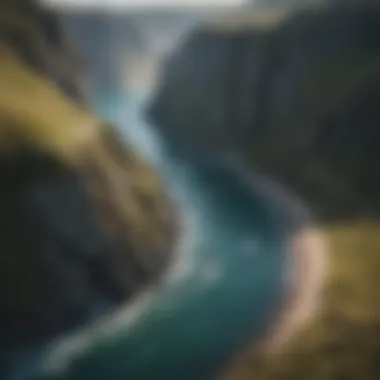Understanding Wind Generation: Mechanisms and Influences


Intro
Understanding wind generation is more than just a scientific concept; it’s vital for anyone involved in outdoor activities, particularly watersports. The dynamic nature of wind influences not only the smoothness of sailing but also the safety and enjoyment of various maritime undertakings. With elements like atmospheric conditions, geographical features, and solar dynamics playing crucial parts, comprehending these factors can be a game-changer for enthusiasts.
This guide aims to provide clarity on how wind is generated, the science behind it, and its implications for watersports. By examining temperature variations, the Coriolis effect, and local terrain influences, readers will garner knowledge essential for making informed decisions while engaging in their favorite activities.
As we embark on this exploration, it’s essential to keep an open mind about the nuances of wind generation. Let's decode its complexities and bring to light practical insights that can enhance our experiences on the water.
Prolusion to Wind Generation
Understanding wind generation is essential for grasping the various dynamics at play in our atmosphere. Wind isn't just a fleeting notion; it's a constant force that shapes our environment, particularly influencing water activities that many enthusiasts hold dear. When delving into the mechanisms of wind, one encounters a tapestry of elements—temperature fluctuations, pressure difference, and even the intricate influence of geography.
Given the increasing urge to harness renewable sources of energy, an exploration into wind generation becomes not just relevant but crucial. For people involved in outdoor sports and adventures, knowing how wind works can significantly change the experience—whether it's sailing smoothly across a lake or catching the perfect wave while surfing. The link between wind patterns and activities like fishing, kayaking, or paragliding cannot be overstated; therefore, this article aims to clarify these connections, painting a comprehensive picture of how wind generation operates.
Defining Wind
At its core, wind is simply the movement of air from areas of high pressure to regions of low pressure. This might sound straightforward, but several intricate factors contribute to how and why this happens.
On a basic level, the heating and cooling of the Earth's surface play pivotal roles in the formation of wind. For instance, when the sun shines down on different surfaces—like asphalt, water, or grass—each absorbs heat at varying rates. The air above these surfaces warms differently, causing localized pockets of air to rise. As this warm air ascends, cooler air rushes in to fill the gap, creating wind.
Furthermore, forces like friction between the wind and the Earth's surface also come into play, affecting the wind's speed and direction. This gives rise to diverse wind patterns, from gentle breezes to fierce gusts. Each distinct wind scenario has implications, particularly for those engaged in water sports because the nature of the wind can dictate usability of the water body.
Significance in Weather Patterns
Wind is a linchpin in the process of weather formation. Without wind, it would be challenging to distribute heat and moisture around the globe. It influences weather systems considerably. For example, it’s what carries moisture-laden clouds across vast distances, sometimes leading to rainfall that nourishes various ecosystems.
Moreover, wind influences local climate conditions. Take the California coast, for example, where wind patterns not only affect temperature but also dictate fog formation and even marine layer weather. Such intricate relationships highlight why understanding wind is vital for both recreational and professional pursuits.
"Wind is nature's way of making waves for water sports enthusiasts; it connects the air and water like a symphony."
In sum, the mechanisms behind wind generation are pivotal in shaping weather patterns around the world. Enthusiasts and adventurers can thus gain practical insights into how wind can either be a helping hand or a hindrance to their activities, depending on whether they understand and can predict it.
The Role of Solar Energy
Solar energy plays a pivotal role in the creation of wind. It is often said that the Sun is the ultimate driver of atmospheric dynamics. By heating the Earth’s surface unevenly, various climates form, resulting in diverse wind patterns. Understanding how solar energy impacts wind generation can offer keen insights for outdoor adventurers and water sports enthusiasts seeking to optimize their activities based on existing conditions.
Temperature Variations
Temperature variations on the Earth’s surface serve as a direct consequence of solar radiation hitting different areas with varying intensities. The equator, bathed in sunlight throughout the year, generates more heat compared to polar regions that receive sunlight at a slant. Such disparities initiate the movement of air, creating the wind. In simpler terms, warmer air rises, while cooler air sinks, leading to the formation of high and low-pressure systems. This ongoing process not only drives wind currents but also influences larger weather patterns.
One might observe the impact of these temperature variations in practice:
- Coastal Breezes: During the day, the land heats faster than the ocean. Warm air rises over the land, and cooler ocean air rushes in to fill the gap, creating refreshing breezes.
- Mountain Winds: In mountainous regions, the sun warms the slopes more quickly than the valleys, causing upslope winds during the day and downslope winds at night. This is where mountain biking enthusiasts may catch their late afternoon rides with exhilarating gusts at their backs.
Heating of the Earth's Surface
The method in which the Earth’s surface absorbs solar energy can significantly affect the generation of wind. Variations in land use, such as urbanization or deforestation, directly influence how effectively solar energy is absorbed. Urban areas, often constructed with materials like concrete, can retain heat much longer than natural landscapes, which affects local wind formations.
In this context, we can highlight several considerations:
- Heat Islands: Cities tend to be warmer than surrounding areas, leading to localized wind patterns. This phenomenon provides favorable winds for kite surfers and other water sports enthusiasts, particularly in late afternoons.
- Natural Terrain: Conversely, areas with abundant vegetation and water, such as parks or lakes, typically cool down more readily. This cooling can lead to different wind behaviors conducive to sailing during the dawn when calmness reigns.
In summary, solar energy's role in wind generation is significant. By understanding both temperature variations and how the Earth's surface heats up, adventurers can better anticipate wind conditions for their excursions. As the saying goes, “Know the land, and you’ll know the breeze.”
"Wind is simply the movement of air, but its cause lies in the sun, which rules every gust.”
Engaging with these concepts not only enriches one’s knowledge of meteorology but also enhances the experience of water-based activities and other outdoor adventures.
By tapping into the intricate dance between solar energy and wind generation, enthusiasts can develop a sharper awareness of their surroundings, ultimately unlocking new levels of enjoyment in their pursuits.
Pressure Systems and Wind Creation


Wind is not just a product of the sun’s heating; it’s intricately linked to pressure systems, fundamentally shaping the atmosphere's dynamics. Understanding how pressure areas—both high and low—contribute to wind creation is essential for anyone interested in meteorology or outdoor activities. These systems are vital not just for forecasting, but also for understanding how they affect conditions for watersports and adventures.
High and Low-Pressure Areas
At the heart of wind generation are high and low-pressure areas, each playing a distinct role in atmospheric behavior. High-pressure areas are zones where air is descending. This cool, dense air suppresses cloud formation, leading to clear skies and calm conditions. Imagine taking a sailboat out on a bright day, with the sun up and winds mild; chances are you’re experiencing a high-pressure system.
Conversely, low-pressure areas signify rising air. As the air ascends, it cools, leading to condensation and cloud formation. This is where you often find stormy weather—imagine peddling a kayak into choppy waters as dark clouds roll in. Such conditions are prevalent in the vicinity of low-pressure systems, which can create unpredictable and sometimes dangerous weather.
- High-pressure features include:
- Low-pressure characteristics:
- Clear skies
- Stable and predictable winds
- Increased cloud cover
- High variability in wind direction
Understanding these zones helps watersport enthusiasts prepare better for their outings. Encounters with changing atmospheric conditions can often make or break a day on the water.
Resulting Air Movements
The shift between high and low-pressure areas generates air movements that are essential for wind creation. Air naturally flows from regions of high pressure to low pressure, trying to seek equilibrium. This flow is where the magic happens—the very essence of wind. While it may seem simple, the interaction of these systems is layered with complexity, influenced by the Coriolis effect and topographical features.
Think of air movement like a huge dance. In open maritime areas, wind flows steadily and predictably, guiding activities like sailing and kiteboarding. However, as the landscape changes—perhaps moving into a forested region or approaching mountain ranges—the air can whip and whirl unpredictably, a challenge for the unprepared.
"Understanding the mechanics of pressure systems not only enhances weather predictions but also enriches the outdoor experience, particularly for water sports enthusiasts."
When you comprehend how these air movements work, you gain a better grasp of what to expect on your next outing. Whether planning for a calm day on the lake or gearing up for waves driven by turbulent winds, awareness of pressure systems keeps you a step ahead. In essence, they are the silent hand behind every gust and breeze you encounter.
Global Wind Circulation
Understanding global wind circulation is key for grasping how wind generation affects the climate and weather systems on our planet. Wind circulation serves as a fundamental mechanism that not only distributes solar energy evenly across the Earth’s surface but also plays a critical role in precipitation patterns, temperate variations, and even the behavior of ocean currents. For water sports enthusiasts and outdoor adventurers, recognizing these global wind patterns can be crucial for planning safe and enjoyable activities.
Coriolis Effect
The Coriolis effect illustrates the way the Earth’s rotation alters the trajectory of moving air. When winds move from high-pressure areas to low-pressure areas, they curve rather than travel in a straight line. This deflection varies depending on whether the movement is in the Northern or Southern Hemisphere, creating the characteristic spiraling patterns of wind. For instance, in the Northern Hemisphere, winds bend to the right, while in the Southern Hemisphere, they veer to the left. This is an essential consideration for anyone interested in wind-related activities. Imagine a sailor trying to navigate across the Atlantic without thinking about how the Coriolis effect could influence their sailing route. Understanding this can help prevent being blown off course.
Trade Winds
Trade winds are another crucial element of global wind circulation. These consistent winds blow from east to west between the equator and approximately 30 degrees latitude. They are historically significant, having propelled sailors during the age of exploration across the oceans. For modern sailors and surfers, knowing the patterns of trade winds can enhance performance and safety. The trade winds create areas of calm known as the Doldrums, which are essential for considering wind conditions during a long voyage. On the flip side, the trade winds also influence the tropical cyclone's trajectory, giving enthusiasts insight into potential hazards in specific regions.
Prevailing Westerlies
Prevailing westerlies, flowing from west to east in mid-latitudes, play a significant role in shaping the weather experienced in many temperate regions. These winds arise due to the combination of the Earth's rotation and the pressure systems in the atmosphere. For outdoor enthusiasts, particularly those engaged in activities like windsurfing or paragliding, understanding these winds can make a world of difference. For example, a winter storm brewing in the Pacific moves into the mainland via these winds, bringing heavy precipitation and strong gusts. Knowing when to expect such conditions can enhance safety and enjoyment while on the water or in the air.
"The patterns of global winds are not just fate; they are the guiding forces of our planet’s climate and weather systems, weaving an intricate tapestry that affects all of us."
Comprehending these global wind elements is essential for maximizing safety and enjoyment during outdoor activities. By identifying wind directions and patterns such as the Coriolis effect, trade winds, and prevailing westerlies, adventurers can better anticipate conditions that will shape their experiences in the great outdoors.
Local Influences on Wind Patterns
Wind patterns don’t just spring from the sky, they are shaped by various local factors that can influence their direction, speed, and intensity. Understanding these influences is crucial for anyone involved in water sports, as they directly affect the conditions for activities such as sailing, surfing, and kayaking. It’s not just about global systems; it’s about how these larger patterns interact with the unique characteristics of a place.
Topography
The lay of the land plays a pivotal role in determining how wind behaves locally. Mountains, valleys, and hills can create wind tunnels or blocks, channeling air in certain directions. For instance, when wind hits a mountain range, it is forced to rise, leading to cooling and sometimes precipitation on the windward side, while creating drier conditions on the leeward side, often referred to as a rain shadow. This differential can create ideal surfing conditions on one side of the mountain while another area remains calm.
This effect is also magnified in coastal areas where high cliffs can funnel winds towards the ocean. Water sports enthusiasts should take note; certain regions may offer favorable wind conditions that are not present in others, all thanks to topographic features. This is especially relevant for kite surfers, as the power of the wind can change drastically depending on where one is located relative to these landforms.
Urbanization Effects
As cities expand, they alter not just the landscape but also the way wind flows through an area. Buildings create obstructions that can redirect or dissipate wind forces, affecting local weather patterns. This phenomenon, known as the urban heat island effect, can create warmer microclimates which, in turn, may impact wind generation.
For water sport aficionados, understanding urban wind behavior is crucial. For example, areas downwind of a large city may experience reduced wind conditions compared to remote, open waters. These shifts can impact sailing regattas or windsurfing competitions, where precise wind knowledge can mean the difference between winning and losing.
Water Bodies and Their Impact


Lakes, rivers, and oceans are not just destinations for adventure; they can significantly influence local wind patterns as well. Water has a moderating effect on temperature, which can lead to distinct wind conditions. For instance, during the day, land heats up faster than water, causing air to rise over the land and drawing in cooler air from the water—a phenomenon well-known to sailors and surfers alike.
"Understanding the interaction between water and wind is key to mastering any water sport. "
In regions bordering large bodies of water, winds can thus be stronger and more consistent than in areas further inland. This can enhance the overall experience for those engaged in activities like canoeing or windsurfing. Additionally, understanding local currents and wind synergy is fundamental to planning any maritime activity.
In sum, local influences on wind patterns are a blend of natural landscape, human development, and aquatic features. They create a unique tapestry that not only dictates the conditions for water sports enthusiasts but also adds complexity to predicting wind behavior. Recognizing these factors enables adventurers to select optimum locations and times for their outings, maximizing both safety and enjoyment.
Seasonal Variability
Understanding the seasonal variability of wind patterns is essential for a variety of reasons, particularly for those involved in outdoor activities and water sports. Each season offers distinct wind characteristics, which can significantly affect both the environment and the experiences of enthusiasts. A keen awareness of how wind changes with the seasons can lead to better planning and safer practices in water-based pursuits.
Changing Wind Patterns with Seasons
Seasons are like a capricious artist; they paint different wind patterns across the landscape. During spring, for example, the air is warmed as the sun rises higher in the sky, leading to more significant temperature differences between land and water. This change prompts local breezes that can create perfect conditions for sailing and kiting, as the winds tend to be more predictable and consistent.
Conversely, autumn often brings more chaotic wind patterns. As summer warmth fades, cold fronts start to sweep in, resulting in sporadic gusts and shifts that can be tricky for novice sailors. In coastal areas, the transition can bring powerful storms that create some of the most intense wind conditions. Experience and knowledge of these seasonal shifts can provide an advantage in navigating such fluctuations.
Additionally, winter winds can be fierce and relentless in certain regions, often leading to stronger gusts due to high-pressure systems dominating the atmosphere. Wind-generating phenomena, like temperature inversions, may occur, which can cause colder air to stay trapped near the ground, influencing how winds behave at higher elevations.
Impact of Seasons on Watersport Activities
The effect of seasonal changes on water sports activities is profound. When planning for adventures on the water, factors such as wind direction, speed, and consistency become paramount. Here are key points to consider:
- Summer: Winds are generally milder, perfect for activities like kayaking and paddleboarding. The steadier breezes tend to make for pleasant conditions.
- Autumn: This season can bring mixed results. While some days feature beautiful, steady winds for sailing, sudden gusts can disrupt a tranquil day on the water.
- Winter: Experienced enthusiasts often thrive during this time, as strong winds generate ideal conditions for surfing. However, safety precautions must be taken, as colder temperatures can add to the risk.
- Spring: A lively season, strong breezes signal the return of water sports. It’s particularly exciting for wind surfers and kite surfers due to interactive wind patterns.
Navigating seasonal variability in wind patterns equips watersport enthusiasts with the knowledge necessary to enhance their experiences on the water.
In summary, seasonal variability in wind generation plays a crucial role in determining activity suitability. Understanding these shifting patterns can mean the difference between a day of delightful adventures and one fraught with challenges. By observing local wind trends and being able to adapt to changing conditions, water sports lovers can truly optimize their time spent immersed in their passion.
Effects of Wind on Water Sports
Wind plays a pivotal role in shaping the conditions under which various water sports are enjoyed. For enthusiasts, understanding wind's impact can be the difference between a thrilling day on the water and an unpleasant experience. From sailing smoothly across a lake to catching the perfect wave while surfing, the dynamics of wind create both opportunities and challenges for athletes of all kinds.
Wind influences not just the speed and direction of water sports activities, but it also impacts safety. For example, strong gusts may create sudden waves or capsizes in sailing and paddling sports. Therefore, comprehending the behavior of wind is crucial for anticipating how it affects water conditions and personal safety.
Sailing and Wind Direction
Sailing thrives on wind direction. The relationship between a sailboat and the wind is a delicate dance; it is a matter of harnessing the right gusts. The sails catch the wind, propelling the boat forward. Prospective sailors must learn the points of sail: close-hauled, beam reach, broad reach, and running. Each point defines the boat's course relative to the wind direction.
For instance, sailing close-hauled, where the boat sails as close to the wind direction as possible, requires skill in trimming the sails and steering. Understanding how to read the wind’s shifts can mean the difference between trailing behind or leading a race.
"In sailboat racing, it’s not just speed; it's about mastering the wind."
Additionally, local geography, such as islands or cliffs, can create wind shadow effects, leading to highly variable wind strengths. Knowledge of these patterns can help sailors make tactical decisions out on the water.
Surfing Conditions Driven by Wind
For surfers, wind conditions directly affect wave quality and surf sessions. Offshore winds, blowing from the land toward the ocean, typically clean up waves, providing a smooth surf surface. Conversely, onshore winds can create choppy water and reduce wave definition, causing less favorable conditions for catching waves.
Different types of waves react uniquely to wind. For example, beach breaks can become noticeably less surfable with strong onshore winds while reef breaks might hold shape better.
Several surfing communities often keep a keen eye on wind reports. Websites, apps, and forums are full of forecasts and local tips telling surfers the best time to hit the waves based on predicted wind patterns. Being a savvy surfer means understanding those subtle shifts – sometimes a mere hour can transform conditions drastically.
Impact on Kayaking and Canoeing
Wind impacts kayaking and canoeing significantly as well. While paddling, wind can change a straightforward outing into a real workout. A headwind can make it challenging to maintain speed and can lead to fatigue quicker than under calm conditions. Even a light breeze can create small waves, affecting stability and maneuverability.
Moreover, lateral winds can push kayakers off course, requiring constant correction. For those participating in competitive races, knowing how wind behaves in specific areas is crucial for strategizing race routes.
On calmer days, wind might help in the form of a gentle tailwind, allowing paddlers to glide effortlessly across the water’s surface. It’s about reading the atmosphere and deciding how to best navigate it. Effective paddlers learn to embrace the wind rather than fight against it. With practice and foresight, they can turn wind conditions into an advantage.
In summary, the air moving over the land and across water creates a complex interplay that effects every kind of water sport. Whether sailing, surfing, or kayaking, engaging with wind dynamics leads to a richer, more informed experience out on the water.


Measuring Wind
Understanding how to measure wind accurately is crucial for various applications, especially for outdoor activities like sailing, surfing, and kayaking. The reliability of these activities often hinges on knowing the wind’s direction and speed. This section dives into the importance of measuring wind, detailing some instruments used for this purpose and how to interpret the data they provide.
Instruments Used for Wind Measurement
Measuring wind involves specialized tools. These instruments, designed to provide essential data, are a lifeline for watersport enthusiasts. Here are some key instruments:
- Anemometer: This common device measures wind speed. Different types exist, including cup anemometers, which use rotating cups to gauge speed, and vane anemometers, which rely on a rotating blade mechanism.
- Wind Vane: This tool determines wind direction. The vane aligns itself with the wind, giving an accurate reading of where the wind is coming from.
- Pitot Tube: Used primarily in meteorology and aviation, this device measures airspeed and can be adapted to gauge wind speed and direction as well.
- SODAR: Sound Detection and Ranging technology, similar to radar, uses sound waves to determine wind profiles at various heights above the ground.
Each tool has its unique benefits. Knowing their distinct features can help enthusiasts choose the right one based on their specific needs.
Interpreting Wind Data
To make the most of the instruments mentioned, understanding how to interpret the data is essential. Raw figures without context can lead to misinformed decisions. Here are some considerations:
- Wind Speed: Measured in knots or miles per hour, different activities require specific wind speeds for optimal enjoyment. For example:
- Wind Direction: This is pivotal, especially in watersports, as it influences water conditions. Understanding the cardinal directions (north, south, east, west) is one half; the other half involves recognizing terms like "onshore" and "offshore."
- Wind Patterns: Recognizing persistent patterns can greatly enhance decision-making. Regularly checking reports and maintaining a record of local wind tendencies could help predict ideal times for specific activities.
- Sailing typically thrives in winds ranging from 10 to 20 knots.
- Surfing is best with wind speeds under 15 knots, as higher winds can produce choppy water.
"Knowledge of wind measurement and interpretation is not just for the seasoned sailor or surfer but for anyone engaging with nature's elements. It’s about reading the signs and making informed choices."
By combining accurate measurement tools with insightful data analysis, watersport enthusiasts can significantly elevate their experiences, ensuring safety and enjoyment in their chosen activities.
Wind Forecasting Techniques
Wind forecasting plays a pivotal role in understanding and utilizing wind resources effectively. Whether you're preparing for a weekend sailing trip or hoping to enjoy a thrilling day of surfing, knowing what the wind is up to can make all the difference. Accurate wind forecasts equip water sports enthusiasts with vital information, allowing them to make informed decisions that ensure safety and enhance enjoyment on the waters.
Technological Advances in Forecasting
In recent years, forecasting technologies have taken tremendous strides, merging traditional meteorological knowledge with advanced computational methods. For instance, satellite imagery provides a bird's-eye view of weather systems, enabling forecasters to observe cloud movements and wind patterns over vast distances. Additionally, Doppler radar systems offer real-time information on wind speed and direction, allowing for immediate adjustments in forecasting outcomes.
With rising computational power, numerical weather prediction models have become increasingly sophisticated. These models simulate atmospheric conditions using mathematical equations, enabling analysts to project future wind behaviors with impressive accuracy. New algorithms also integrate data from various sources, such as weather stations and ocean buoys, forming a more comprehensive picture of the atmosphere at any given moment.
These advancements lead to an essential benefit: timely alerts. When wind conditions change rapidly, having immediate access to updated forecasts helps water sports enthusiasts avoid hazardous situations, whether it's gusty winds that can capsize a vessel or unexpected squalls that can alter a surf session.
Practical Applications for Watersport Enthusiasts
Understanding and applying wind forecasting technology can greatly augment the experience for those engaged in water sports. Here are a few practical applications that illustrate its relevance:
- Sailing Competitions: Sailors rely heavily on wind forecasts to devise strategies for races. Knowing when and where the winds will be favorable enables competitors to plot the fastest course.
- Surfing Plans: Surfers can optimize their outings by aligning their schedules with peak wind conditions, which often coincide with the best surf. Wind reports that detail onshore or offshore conditions can help surfers choose ideal beaches and times for catching optimal waves.
- Safety Precautions: Whether you’re kayakking or paddleboarding, understanding wind dynamics can be crucial for safety. Forecasts indicating increasing winds can alert adventurers to head back before conditions become perilous.
"An accurate wind forecast can make the difference between a day of exhilarating fun and a challenging encounter at sea."
In summary, as we delve deeper into the dynamics of wind generation, recognizing how innovative forecasting techniques work is critical. Embracing these advancements builds a bridge between understanding natural phenomena and enjoying them responsibly. Armed with accurate wind forecasts, water sports enthusiasts can navigate their passions on the water with confidence and safety.
End
In the realm of wind generation, the conclusion serves as more than just a wrap-up; it crystallizes the intricate connections explored throughout the article. Understanding how wind is created and influenced by multiple factors is paramount, especially for those who engage in water sports. The various atmospheric conditions, geographical elements, and solar dynamics all weave together a complex tapestry that dictates wind behavior. By grasping these concepts, enthusiasts can make informed decisions, optimizing their experiences on the water.
Moreover, the insights gleaned from this discussion extend beyond mere appreciation for the natural phenomena. They equip adventurers with knowledge that aids in predicting conditions that affect safety and performance. For example, recognizing how seasonal shifts can impact wind patterns allows sailors, surfers, and kayakers to plan their activities with greater assurance.
Understanding the mechanisms behind wind generation also provides a context for the future of our interaction with the environment. The evolving impacts of climate change raise questions regarding shifting wind patterns that may redefine water sports and other outdoor activities in upcoming years.
Summary of Key Points
- Atmospheric Influencers: Recognizing how pressure systems and temperature variations contribute to wind generation is vital.
- Geographical Impact: Local features such as mountains and bodies of water significantly shape wind direction and speed.
- Coriolis Effect: Understanding this effect is crucial to Marine navigation and predicting long-range wind patterns.
- Technological Insights: Advances in forecasting technology help enthusiasts prepare for various wind conditions, enhancing their overall safety and enjoyment.
"Wind generation is not just about movement; it’s about understanding the forces that shape our experiences and adventures on the water."
Future Outlook on Wind Patterns and Their Implications
As we look ahead, the future of wind generation is likely to be characterized by unpredictable changes brought on by climate change. The shifting of global weather patterns may cause once reliable wind currents to behave differently, posing new challenges for outdoor activities. For instance, regions that traditionally offered consistent winds for sailing or surfing could find themselves experiencing erratic conditions.
Furthermore, advances in technology will play an important role in helping us adapt. Integration of AI and machine learning in weather forecasting promises to bring about more precise predictions, critical for watersport enthusiasts who rely on accurate information to plan their activities.
In an era where environmental concerns are increasingly significant, understanding the implications of wind patterns on both human activity and ecosystems will be crucial. This knowledge may lead to a greater emphasis on sustainable practices and innovative ways to enjoy outdoor adventures responsibly.
Ultimately, as we explore the potential shifts in wind behavior, preparation and adaptability will be key for water sports enthusiasts navigating the ever-changing conditions.















